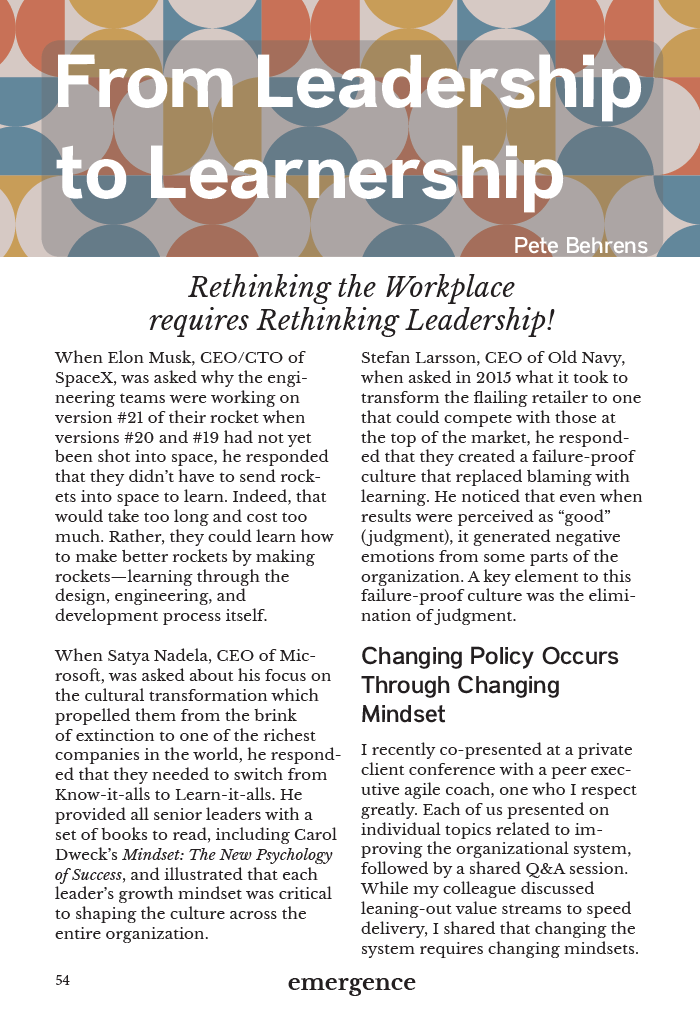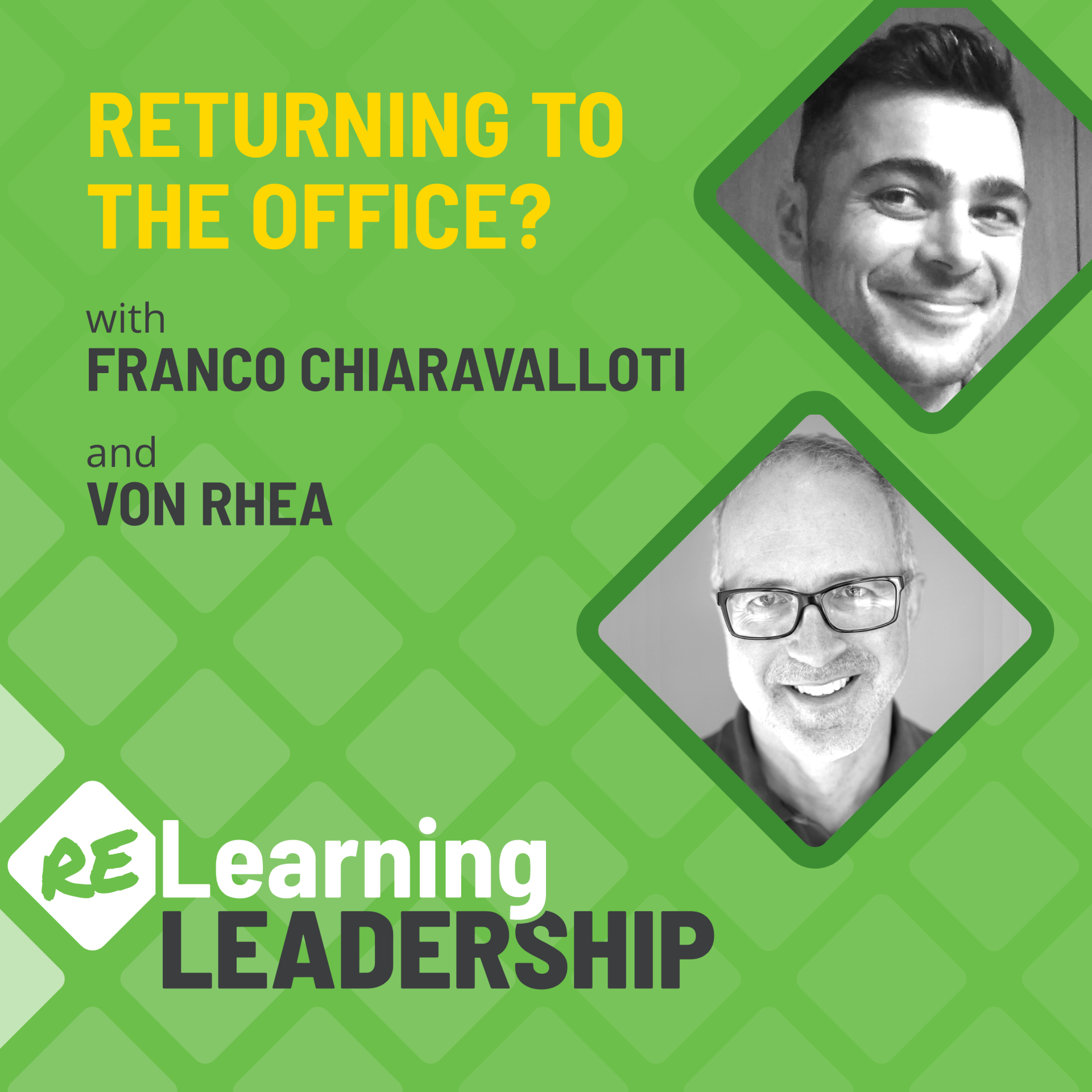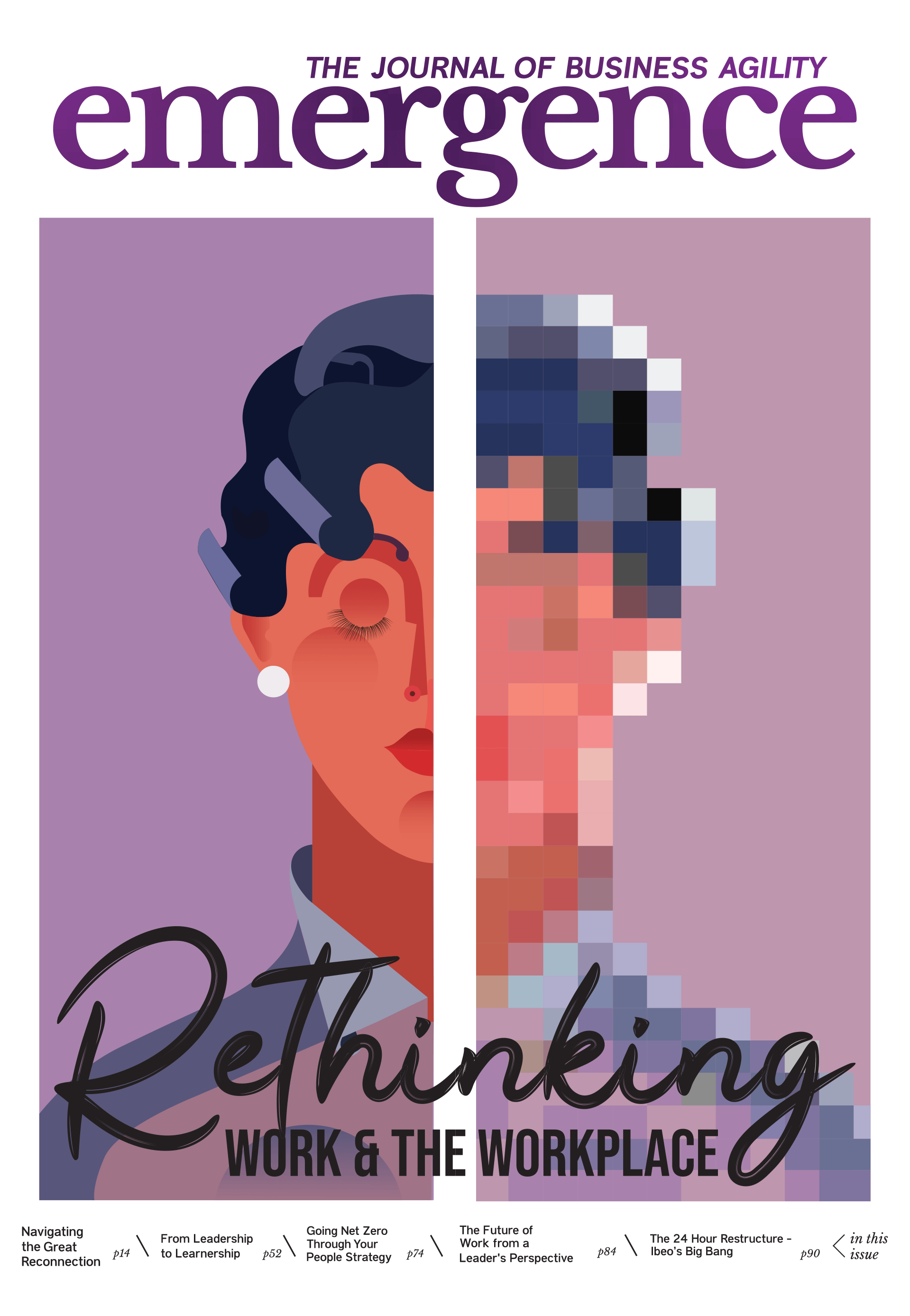From Leadership To Learnership
Rethinking the workplace requires rethinking leadership!
When Elon Musk, CEO/CTO of SpaceX, was asked why the engineering teams were working on version #21 of their rocket when versions #20 and #19 had not yet been shot into space, he responded that they didn’t have to send rockets into space to learn. Indeed, that would take too long and cost too much. Rather, they could learn how to make better rockets by making rockets—learning through the design, engineering, and development process itself.
When Satya Nadela, CEO of Microsoft, was asked about his focus on the cultural transformation which propelled them from the brink
of extinction to one of the richest companies in the world, he responded that they needed to switch from Know-it-alls to Learn-it-alls. He provided all senior leaders with a set of books to read, including Carol Dweck’s Mindset: The New Psychology of Success, and illustrated that each leader’s growth mindset was critical to shaping the culture across the entire organization.
Stefan Larsson, CEO of Old Navy, when asked in 2015 what it took to transform the flailing retailer to one that could compete with those at the top of the market, he responded that they created a failure-proof culture that replaced blaming with learning. He noticed that even when results were perceived as “good” (judgment), it generated negative emotions from some parts of the organization. A key element to this failure-proof culture was the elimination of judgment.
Changing policy occurs through changing mindset
I recently co-presented at a private client conference with a peer executive agile coach, one who I respect greatly. Each of us presented on individual topics related to improving the organizational system, followed by a shared Q&A session. While my colleague discussed leaning-out value streams to speed delivery, I shared that changing the system requires changing mindsets.
The Q&A portion following our talks was a shared stage, which allowed us a bit of welcome banter on each of the questions. A question was asked of my colleague regarding how to change the budget process in order to more effectively lean-out the value stream—in other words, how to enable more iterative and incremental project funding. I recall my colleague responded to this technical question with an eloquent, yet equally technical response. Following his response, I added a simple point: unless the leaders responsible for those funding policies change their beliefs about risk, those financial policies will never change. <mic drop>
Essentially every policy in an organization is developed from a basis of risk tolerance and trust of the leaders of that organization. This applies whether it’s about the rules to follow in order to request, gain approval, and take time off from work; or the authority to make decisions and spend money; or setting goals and measuring their progress, success, and “failure”.
That last word is of particular significance. “Failure” is often a trigger point. Thomas Edison famously said, “I have not failed. I’ve just found ten thousand ways that won’t work.” As Stefan Larsson at Old Navy explained, “the only difference between failure and learning is perspective.” Tomato, Tomahto? Not so fast. It’s only perspective if it remains an opinion. However, when opinion and perspective turn into policy, sh*t gets real! (Can I say that?)
A tale of two companies
It was the best of times, it was the worst of times…
Let’s take a look at two organizations whose leaders drove pandemic-era policies based on different perspectives of risk tolerance and trust.
Organization A focuses on the industrial technology industry with a dozen or more product teams spread across the globe. Organization B focuses on the mortgage technology industry with a dozen or more product teams co-located in a major US city. Different industries, but both employ tech knowledge workers who can work remotely (as opposed to front-line, supply chain, and others required to physically interact with goods).
Prior to the pandemic, Organization A and B had very different working from office/home policies. While Organization A enabled a remote workforce, and had many employees living in locations without local offices, Organization B required employees to work from the office unless unique circumstances dictated otherwise. Both were profitable and growing.
Throughout the pandemic, Organization A suffered relatively little impact as it transitioned to full time work-from-home operations. While travel was restricted/eliminated, product development continued remotely. Organization B’s shift to working-from-home was a bit more challenging as it required some tech upgrades to support its newly remote workforce. Organization B further required workers to return to the office in August 2021 (halfway through the heart of the pandemic!). This action created conflict that was felt by employees and spotlighted by the media, as it didn’t discuss or clarify mask-wearing, distancing, and gathering norms.
Taking a look below each of these policies, we can see different leadership perspectives. Organization A is demonstrating more trust and enabling more freedom (risk tolerance) and flexibility. Organization B is demonstrating less trust and constraining freedom (risk averse) and flexibility. And while both organizations are demonstrating positive results, Organization A’s attrition rate is half of Organization B’s.
Our point is NOT to praise Organization A and condemn Organization B, but rather to point out how leadership mindset and perspectives on trust and risk tolerance drive policies.
If we want to change the way we work, we need to access the way leaders think.
If we want to change the way we work, leaders must be willing to get messy.
Don’t Put-Up or Shut-Up: Mess It Up
We could put these two organizations on a spectrum of culture: put-up and shut-up.
“Put-up” cultures are built on tolerance where leaders allow variant behavior. On the positive side, a put-up culture creates freedom and flexibility, like Organization A above. On the negative side, put-up cultures enable disrupted behavior to continue, like a dog being allowed to pull on its leash, or a parent giving in to a child’s tantrum. Over time, these tolerated behaviors become the norm, even if dysfunctional. Organization A may see issues ahead as they seek to develop more organizational cohesiveness.
“Shut-up” cultures are built through a lack of tolerance to variant behavior. On the positive side, a shut-up culture creates consistency and predictability, like Organization B. On the negative side, shut-up cultures limit situational adaptability and may constrain innovation. Organization B is seeing the downside of this through employee attrition. In these cultures, leaders “shut-up” variant behavior—treating policies as rules versus guidelines. In contrast, in put-up cultures, policies are treated as guidelines rather than rules. The best cultures of all are formed through finding a balance between the two polarities (though this is easier said than done). Culture forms through the constant negotiation of norms and behaviors, tolerances, and consequences. This is the messy part—finding the right balance.
While it may be easy to judge the two organizations above as “good” or “bad”, reality is more complex. Both organizations, A and B, likely require some discussion and some negotiation in their policies to find a better balance, especially as the pandemic landscape continues to shift.
From tacit to transparent
None of us are immune to policy implications. Every team is influenced by policies, even ones that are loosely defined or not spelled out. A small organization with entirely remote staff have little reason to create or enforce a policy surrounding vaccines and in-person protocols throughout the pandemic. They have been operating effectively in a remote way before the pandemic and continued operating in this manner throughout it. They would sit closer to the “put-up” side of the aforementioned spectrum—valuing individual freedom and flexibility over consistency and predictability.
Their team members, like every organization, had passionate and differing opinions about the efficacy of vaccines, along with the responsibilities they had to the greater public in protecting immunocompromised individuals, healthcare professionals, and the elderly. During the pandemic, the more “encourage to vaccinate” perspectives spilled over in team meetings, while the more “cautious to vaccinate” views stayed silent. Over time this environment began to eat at the team’s culture. However, this toxicity stayed below the surface because its members either didn’t feel comfortable exposing the difference, or were unaware that it was an issue.
But as time passed, in-person gatherings began to be reconsidered and in-person conferences were renewed, the issue began to surface into the team business context. Given this, the leader shifted the tacit policies and perspectives into an open dialogue. This took incredible courage and vulnerability for people to share. It also exposed a lot of hurt and pain that was hidden for so long.
The leader applied one of our growth mindset principles referenced from Adam Grant’s Book,Think Again—separating held beliefs and shared beliefs. By preaching our beliefs, and prosecuting others’ beliefs, we drive a wedge between us, spark defensive actions, and build sides. Instead, Grant suggests thinking as a scientist by using hypotheses for our own beliefs and curiosity for others’ beliefs. Recognize that this does not mean hiding beliefs. Rather, it means exposing them with open-mindedness on both sides. Hiding ideas only pushes them deeper, creating a more challenging situation later.
As of this writing, the team mentioned previously is still engaged in an ongoing dialogue, and I am proud that they were able to “go there”, exposing differences, and getting messy. I am hopeful that they will emerge stronger because of their journey.
Edgar Schein, a significant voice on organizational culture, illustrates culture as a series of layers. These layers include the visible elements within the office, the values modeled with-in the organization, and the beliefs and basic assumptions held by the organization’s leaders. Policies (both implicit and explicit) are the visible signs of culture that emanate from the hidden layers below. In order
to challenge and change policies, leaders must be able to get below the surface and explore their values, beliefs, and basic assumptions, just as this team did with their vaccine discussion.
If we want to change the way we work, we need to be willing to get below the surface.
Rethinking the Workplace
In this year’s State of the Union address, President Biden pleaded for workers to return to the office. “It’s time for Americans to get back to work and fill our great downtowns again. People working from home can feel safe to begin to return to the office.” Do you notice the language and focus? Work is physical. Work means commuting to an office, in a downtown, to foster a pre-pandemic economic ecosystem. Biden is veering towards a “shut-up” culture.
CEOs of major corporations are echoing similar sentiments. Google has asked most of its workforce to come back three days per week. Microsoft has been working through its six stages of hybrid workplace, entering into their final phase this past month where offices are back open. I appreciate how these leaders are seeking some balance, but we have yet to see how messy they are willing to get.
Leaders at all levels are grappling with return-to-the-office policies. I believe middle management is in the worst situation: leaders above them dictate the policies and then make middle management responsible for enforcement with employees. That feels like a no-win situation. In a recent episode on the (Re)Learning Leadership Podcast, Franco Chiaravalloti of Hitachi Rail Systems and Von Rhea of Trimble, Inc. explored returning to the office and the various pressures, hopes, and anxieties they feel as middle-level leaders navigating this ever-changing landscape.
In the episode, Franco shared concerns that his leaders might forget how productive their teams were in remote work. Von shared how future solutions will require a degree of individualization as the work/life balance for each employee has different drivers. Where some would benefit from an occasional day or two work-ing from home; others would prefer full-time office work or half-days in the office five days a week. There are other employees who would benefit from a full time work-from-home policy. Thus, even with corporate policies, all leaders must get messy and expose beliefs to help all employees work through it.
From leadership to learnership
As we seek to rethink the workplace, it might be best for us to first look internally. Our beliefs and assumptions will guide our culture. Leadership is not dictating policy we feel is “right”. Leadership is also not allowing employees to do what they feel is “right”. Leadership requires the courage to expose varying beliefs and assumptions, and the vulnerability to get messy in the dialogue. This is learnership—leadership that is willing and able to learn.
Dean Leffingwell, founder of Scaled Agile Framework, during an inter-iew on the (Re)Learning Leadership Podcast, said, “I personally believe that the leadership model for the next couple of decades is learning. And I think the companies that learn better are going to be better than those that don’t.” That is learnership. Elon Musk, Satya Nadella, and Stefan Larsson each demonstrated learner-ship in their responses at the top of this article.
Learnership is shifting from being right to being curious. Learnership does not “put-up” or “shut-up”, but rather has the courage to “mess it up”. Learnership is shifting from preach-ing your beliefs and prosecuting others’ beliefs to exploring differing beliefs. Learnership is a lifelong pursuit of better.
Learnership is not only for CEOs and the most senior leaders of an organization. Learnership can improve every leader at every level of the organization, regardless of title and authority.
Learnership is not just about rethink-ing the workplace. Learnership is a competency that opens up new possibilities in all aspects of work including improving products, processes, and people.
I hope to see you on the learnership journey.
This content was originally published in the May 2022 Edition of Emergence, The Journal of Business Agility. It has been republished here with the permission of the publication.
What is Emergence?
Emergence is the Journal of Business Agility from the Business Agility Institute. Four times a year, they produce a curated selection of exclusive stories by great thinkers and practitioners from around the globe. These stories, research reports, and articles were selected to broaden your horizons and spark your creativity.









